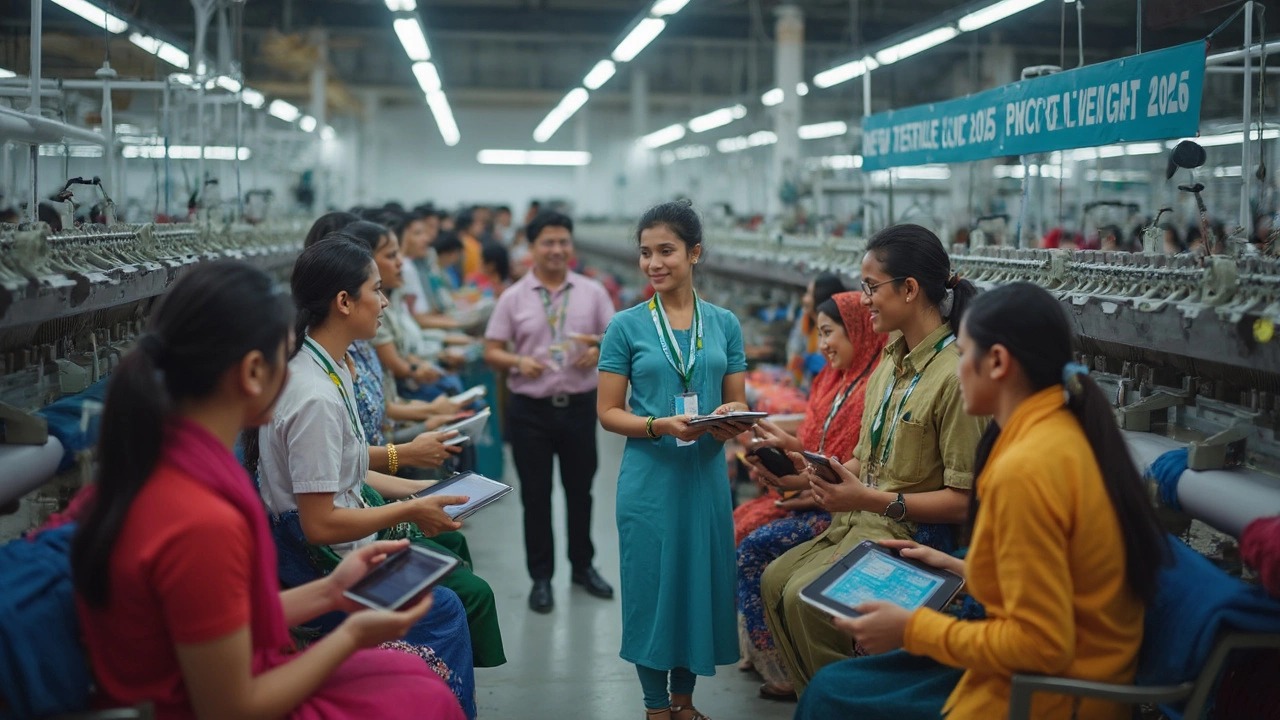 Apr, 29 2025
Apr, 29 2025
Textile manufacturers in India are watching things closely this year. India just rolled out a new textile policy that’s turning heads—not just for what’s new, but for what it targets. If you’re in this industry or even eyeing it, you can’t afford to ignore what’s going down.
The government isn’t shying away from bold moves. The new textile policy throws out fresh incentives, pushes technology upgrades, and wants factories—big and small—to step up their game for the world market. It’s not just paper talk, either. Already, there are cash rewards lined up for boosting exports, and tighter standards for everything from labor rights to sustainable production. Suddenly, everyone’s talking about compliance audits and digital tracking like it’s the new normal.
Worried about costs or getting squeezed by global competition? The policy includes special incentives for MSMEs (that’s micro, small, and medium enterprises) to help them streamline processes and cut red tape. That means easier documentation, targeted subsidies, and help with export paperwork. It’s the kind of stuff that can actually move the needle for smaller units.
If you’re confused about how this change could help—or hurt—your setup, you’re not alone. Knowing the nuts and bolts of these updates is the only way to stay ahead once they start kicking in. Stick around for the practical how-tos and watch-outs that every manufacturer needs to get right.
- Why India Needs a New Textile Policy
- Key Changes and What They Mean for Manufacturers
- Export Focus: Boosting India’s Global Textile Game
- Staying Compliant and Getting the Most out of the Policy
Why India Needs a New Textile Policy
The India textile policy overhaul didn’t just land out of nowhere. The industry has been stuck with old rules and habits that just don’t cut it anymore. Imagine powering a modern factory while following compliance laws from the ‘80s—a lot of things just don’t line up, especially if you want to play big in the export market.
First off, let’s talk numbers. Textiles make up over 10% of India’s total exports and employ about 45 million people directly—making it one of the country’s largest employers outside agriculture. But competitors like Bangladesh and Vietnam have started passing India by, mainly because they updated their policies and tech way faster. If India wants to keep its edge, the rules have to catch up.
The old policies didn’t really cover today’s challenges. Rising labor costs, stricter global compliance for sustainability, and crazy competition from low-cost countries have made life tough for textile manufacturers India wide. Buyers in Europe and the US, for example, now demand traceable supply chains, eco-friendly fibers, and proof that workers are treated right. The last policy couldn’t handle any of this.
On top of that, small- and medium-sized players (the MSMEs) were loaded down by red tape. Delays with permits, access to finance, and export hurdles made it tricky for anyone who wasn’t already a big name. India saw growth slowing—and some factories shutting down for good—which made updating the Indian textile industry playbook a must.
- The global market wants eco-friendly, tech-enabled production—old policies just ignored that.
- Labor laws needed tightening up to keep up with international buyers’ expectations.
- Red tape choked small manufacturers who couldn’t wait weeks for import/export paperwork.
- India risked losing out not just on sales, but also on jobs—especially for women, who make up a huge chunk of the textile workforce.
| Country | 2023 Textile Export Share (%) | Major Strength |
|---|---|---|
| India | 4.3 | Diverse products, skilled labor |
| Bangladesh | 6.5 | Low manufacturing costs |
| Vietnam | 6.0 | Tech-savvy factories |
Peppering in modern regulation and solid incentives isn’t just about keeping up—it's about actually setting fresh goals for local factories and exporters. The new policy is a move to tackle all of this, straight on.
Key Changes and What They Mean for Manufacturers
The new India textile policy for 2025 isn’t just a minor update. It’s packed with changes that manufacturers will feel right away on the ground. First off, the government has put out a Production Linked Incentive (PLI) scheme that means direct cash rewards for companies that boost their production and hit export targets. So if you’re exporting more, you’ll actually see money come back into your business faster than before.
Another key shift is the threshold for compliance. Manufacturers now have to record every step digitally—this goes for raw material sourcing, labor payments, and environmental checks. Audits are going online, and surprise inspections are expected to happen more often. This change is aimed at reducing shady practices and building trust with big buyers overseas who want transparency.
The policy also rolls out mandatory eco-certifications. If your setup isn’t cutting down water and power usage or managing waste, you could miss out on big buyers and even get blocked from exporting to markets like Europe. In 2024, over 70% of global buyers asked for proof of eco-friendly processes—so India’s policy is a direct response to stay relevant worldwide.
| Change | What It Means |
|---|---|
| Production Linked Incentives | Get paid to boost production & meet export goals. |
| Digital Compliance Tracking | Log processes online, prepare for more audits. |
| Mandatory Eco-Certifications | Prove your sustainability or risk losing out. |
| Subsidies for MSMEs | Special grants and low-interest loans for small/mid units. |
For textile manufacturers India relies on, another highlight is the easier access to government support. MSMEs—that’s most of the factories—can now apply for tech upgradation grants via a simple portal. No more heaps of paperwork or bribes needed to push files through. With new tech, even smaller players can gear up for automation and bulk orders from global clients.
And don’t forget labor. For the first time, there’s pressure to move toward formal hiring practices—meaning social security, proper contracts, and clear shift timings. The goal is not just to look good on paper but to stop the worker shortages and strikes that slow things down when orders spike.
If you’re looking to stay in the game, plan for regular compliance check-ups and keep your tech and process upgrades on track. Missing out or delaying documentation could mean big losses, or worse, missing out on the new incentives that could help your business grow.

Export Focus: Boosting India’s Global Textile Game
India’s new textile policy isn’t just about keeping factories running—it’s a direct shot at making India textile policy work for global markets. The government has made it clear: they want India to be in the top three textile exporters worldwide. Right now, the country sits at number five, but with new rules and support, that could change quickly.
The most obvious push? Textile manufacturers India are being offered export-linked incentives. If your business boosts foreign sales, you could qualify for direct subsidies and tax breaks. The goal is to encourage exports of value-added products—like finished apparel and technical textiles—instead of just raw materials or yarn.
You’re also going to see a lot more export assistance centers. These setups are designed to help smaller units with documentation, compliance checks, and fast-tracking shipment approvals. Instead of fighting red tape, you get specialist help to speed up processes and avoid unnecessary fines.
Here’s a quick look at some export-focused changes:
- Production Linked Incentive (PLI) Scheme: This targets companies who can ramp up exports in man-made fibers and technical textiles. If you meet the benchmarks, you get cash directly from the government.
- Market Diversification: Subsidized trade delegations and sponsored industry fairs in new regions—think Africa and South America—so you don’t rely only on the US or Europe.
- Infrastructure Upgrades: Modernizing ports for direct textile shipping, and pushing for smart warehouses to help with faster order fulfillment.
If you’re wondering what the numbers look like, check out this table showing the top five export destinations for Indian textiles in 2024:
| Country | 2024 Export Value (USD Billion) |
|---|---|
| USA | 9.5 |
| Bangladesh | 4.2 |
| Germany | 3.7 |
| UK | 2.8 |
| UAE | 2.4 |
The policy is also demanding traceability. Factories will have to log their export chain digitally—a move meant to satisfy global buyers who want proof of ethical sourcing. If you want your Indian textile industry operation to cash in, getting digital-ready fast is a must.
Bottom line? The new India textile policy is doubling down on exports, offering real perks for those ready to adapt. If you’re not thinking global, you’re missing the entire point of these changes.
Staying Compliant and Getting the Most out of the Policy
With the new India textile policy in action, compliance isn’t just paperwork—it's make or break for textile manufacturers. The government has set stricter audit schedules and real-time digital monitoring. Some states now require monthly online reporting on labor compliance and environmental standards. If you slip up, you could lose out on export incentives or even face temporary shutdowns.
Here’s what helps most manufacturers stay out of the red zone:
- Set up a digital tracking system. The policy recommends RFID-based tracking for raw material and finished goods. It can make passing inspections a breeze.
- Keep workforce records updated—government auditors now check for minimum wage compliance, basic facilities, and regular trainings.
- Don’t forget about environmental rules. Factories are expected to show water recycling and waste-management logs. Some districts, especially in Gujarat and Tamil Nadu, are doing random water use checks twice a year.
- Sign up for government e-portal updates. Policy briefs, grant announcements, and compliance checklist tools now go through the National Single Window System. Staying subscribed means you’re less likely to miss out.
The incentives for getting compliant are legit. Registered units with zero critical violations in 2024-25 are getting tax rebates up to 15%, extra export subsidies, and fast-track bank loans. And if you’re an MSME, you get first dibs on tech upgradation grants. For big manufacturers, there’s a big push to hit the 'zero discharge' mark using low-impact dyes by 2027—this gets you bonus points for export permits.
Check this summary of real perks for compliant units (as reported by the Ministry of Textiles):
| Benefit Type | Value/Range | Eligibility |
|---|---|---|
| Tax Rebate | 10-15% | Zero critical violations (annual audit) |
| Export Subsidy | 5% more per contract | Audit clearance + Digital traceability |
| Tech Grant (MSME) | Up to ₹20 lakh/unit | MSME registration + digital compliance |
Every textile manufacturer in India should get their compliance team up to speed now, if they haven’t already. Even one missed filing, or a gap in digital logs, could stall your business growth for months. The bottom line? Stay on top of reports, digitize your workflow, and use every update from government dashboards to your advantage. Being proactive isn’t just about avoiding penalties—it’s about making the most out of the new textile policy while competitors are still playing catch-up.